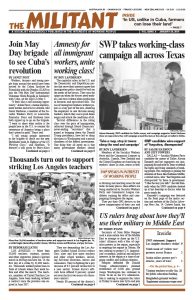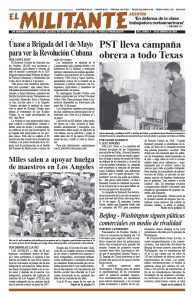LOS ANGELES — More than 30,000 teachers, students, parents and other supporters joined a spirited march in driving rain here Jan. 14, the first day of a strike by 31,000 teachers. Thousands walked picket lines in front of schools where they work before and after the march. The teachers, members of United Teachers Los Angeles, have been working without a contract since the previous one expired in June 2017.
They are demanding the Los Angeles Unified School District reduce class sizes and hire more teachers and other school workers, including full-time librarians, nurses and counselors. They’re fighting for a pay increase of 6.5 percent retroactive to a year earlier. School district officials have offered 6 percent, spread out over the first two years of a three-year contract.
Nearly 80 percent of the district’s over 600,000 students didn’t come to school on the first day of the strike. Many joined the march.
“Only 60 kids showed up today out of the approximately 500 who attend school here,” Jennifer Zelazny told the Militant as she and some 30 teachers picketed in front of Alta Loma Elementary School before heading to the rally. “Even those parents who brought their children to school say they support the strike. They have to work or depend on the meals.”
At Dorsey High School teachers and others picketed in front of the school and then went to the rally together on public transportation.
Strike signs printed by the union and handmade signs and slogans written on umbrellas dotted the rain-soaked rally. Some carried signs or wore ponchos from other unions, including Service Employees International Union, International Longshore and Warehouse Union, National Union of Healthcare Workers and California Faculty Association. The Los Angeles County Federation of Labor is backing the strike.
Widespread support for the strike
One group of parents set up a Facebook group called Parents Supporting Teachers. It has more than 10,000 members who share ideas for strike-day activities for children and offer their homes for bathroom breaks for picketers as well as other kinds of support.
In the face of widespread support for the union’s demands, district officials are now proposing to fund a librarian for every secondary school, an extra academic counselor for high schools and a full-time nurse for every elementary school. But they only guarantee it for one year, which union officials say won’t work.
School officials claim the district will be bankrupt if it meets the teachers’ demands, regardless of how “worthy” they are. The union answers by showing the district is sitting on a $1.86 billion reserve.
“Class sizes have gone up a lot. Everyone thinks it’s the pay increase. That has a lot to do with it, but class size is the main thing,” Kevin Alfaro, a social studies teacher at Kennedy High School in Granada Hills, told the Los Angeles Times. His four advanced placement government classes have 40 or more students each.
While class sizes are also her number one concern, Marshall High physical education teacher Lin Joy Hom told the Times that she also wants every school to have a full-time nurse.
“I can’t tell a kid, ‘Don’t get hurt on Tuesday because there’s no nurse,’” she said. “We need a nurse every single day.”
The district has hired about 400 substitutes and reorganized 2,000 district staff to cross the picket lines and keep schools open during the strike.
Some strikers and supporters have taken initiatives to strengthen the walkout. Joel Laguna, a sixth grade history teacher at Thomas Starr King Middle School in the Silver Lake neighborhood, told NPR that 80 to 90 percent of Los Angeles students get free or reduced cost lunches.
“A lot of parents from the richer neighborhoods can keep their kids at home. They can hire babysitters,” he said. “On the other end, we have parents who work two, three jobs, right?” Not being able to get child care or the school-provided meals is “a serious challenge,” he said.
Laguna is working with other teachers at his school to make sure students can get food during the strike. When they are not on the picket line, “we’re going to be making bag lunches” students can pick up every day at the picket line, he said.
For ongoing information and to find out about strike support activities, contact www.wearepublicschools.org.


